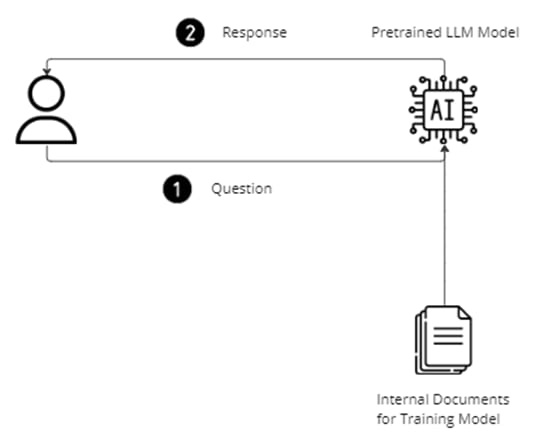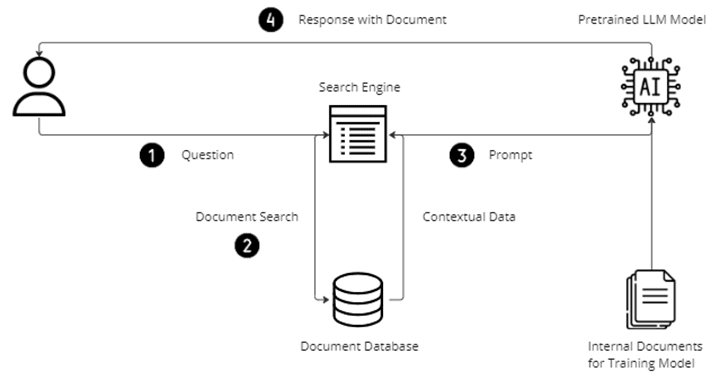In the year following the launch of ChatGPT, Artificial Intelligence (AI) has undergone a significant transformation, largely driven by the emergence of Retrieval Augmented Generation (RAG). This advancement in technology has been pivotal in refining communication, boosting efficiency, and unlocking new potential across a wide range of industries. Particularly noteworthy is the role of RAG in the evolution and widespread adoption of Large Language Model (LLM) technology, presenting a straightforward yet effective solution to various AI-related challenges.
This article was written by Cem Adiyaman ([email protected]) and Chung Do ([email protected]), who are part of RSM Technology Consulting team. RSM’s Technology Services empower businesses to unlock the potential of data principles for sustainable growth and positive impact.
Comprehensive Understanding of RAG
RAG represents a significant enhancement over traditional LLMs. An LLM can be compared to a knowledgeable student, absorbing vast amounts of information to learn and formulating accurate responses. However, LLMs often lack control in their response generation, leading to unpredictability and concerns over reliability. RAG addresses these issues by introducing an approach similar to consulting a virtual librarian, who provides not only answers but also pertinent documentary references. This amalgamation of search and generation capabilities significantly improves the efficiency and depth of interactions. For instance, BING chat’s deployment of RAG provides users with answers from the LLM and links to related online resources.

Figure 1: Simple LLM Model
RAG operates through a clear, four-step methodology. It starts with users asking their question. Then, a similarity check within a database of documents is activated to identify the most relevant source, referred to as Document A. After that, it combines the user's query, Document A, and the LLM to generate a response. The final step involves presenting both the answer and the related document, simplifying the information retrieval process.

Figure 2: RAG LLM Model
The integration of Retrieval Augmented Generation (RAG) into business operations marks a significant advancement for small and medium enterprises (SMEs). This technology goes beyond conventional AI applications, representing a strategic shift in how businesses handle information processing and decision-making. With RAG, companies experience enhanced accuracy in information retrieval and data analysis. Traditional AI models, although beneficial, often lacked precision and reliability in data handling, leading to gaps in decision-making processes. RAG addresses these issues by combining response generation with access to relevant and verified information sources, ensuring faster and more accurate data processing. This capability is especially beneficial for sectors like legal advisory, consulting, and market research, where up-to-date and accurate information is crucial.
Furthermore, RAG empowers users with greater control over AI-generated responses, significantly improving the reliability of outputs and the decision-making process. This enhances control and accuracy, in turn, elevates the overall user experience, with customers and internal team members benefiting from more coherent, relevant, and trustworthy AI interactions. In the rapidly evolving landscape of generative AI systems, RAG provides SMEs with a competitive edge through state-of-the-art applications, enabling them not just to keep pace with technological advancements but to lead in their respective fields. However, the integration of RAG also introduces challenges, particularly in ensuring ethical usage and governance of AI technology. Companies must be vigilant in aligning RAG with regulatory standards and ethical norms, navigating the complex regulatory and ethical landscapes to harness its full potential responsibly.
Looking towards the future, the possibilities for RAG in various sectors seem boundless, opening up exciting avenues for innovation and business efficiency. As RAG becomes increasingly integrated into business processes, it acts as a catalyst for further technological innovation within SMEs, streamlining information retrieval and analysis, and paving the way for creative problem-solving and product development. This transformative technology is not just an upgrade; it's a movement towards smarter, more efficient business models in the digital age. The strategic implementation of RAG is set to shape the future of business in an AI-driven world, offering SMEs the tools not only for enhancing current operations but also for pioneering future growth and innovation.
Forward Thinking
In conclusion, as companies consider implementing Retrieval Augmented Generation (RAG) into their operations, several key actions and prerequisites are essential for a successful integration. Firstly, businesses must conduct a thorough assessment of their current technological infrastructure and data management systems to ensure compatibility with RAG technology. It is crucial to have a solid foundation in data handling and AI capabilities as a starting point.
Secondly, companies should invest in training and development programs for their staff to familiarize them with RAG functionalities and best practices. This step is vital for maximizing the benefits of RAG and ensuring seamless integration into existing workflows. Additionally, businesses must establish clear objectives and strategies for how RAG will be used to enhance their operations. This includes identifying specific areas where RAG can improve efficiency, decision-making, and customer engagement.
Another essential action is to ensure compliance with all relevant legal and regulatory standards, particularly concerning data privacy and ethical AI use. Companies should consult with legal experts to navigate these complex areas and develop a compliance framework. Lastly, businesses must stay abreast of ongoing advancements in AI and RAG technologies. Staying informed and adaptable will enable companies to continuously optimize the use of RAG in their operations and maintain a competitive edge.
By taking these actions and ensuring these must-haves are in place, companies can effectively harness the power of RAG, transforming their business processes and positioning themselves for success in the dynamic landscape of AI-driven business solutions.

